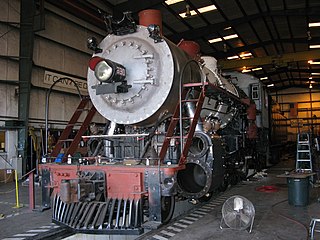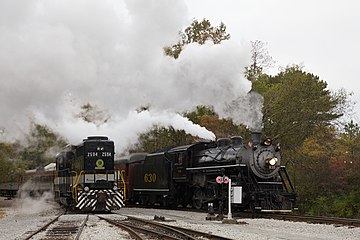Southern Railway 630
| Southern Railway 630 | |||||||||||||||||||||||||||||
|---|---|---|---|---|---|---|---|---|---|---|---|---|---|---|---|---|---|---|---|---|---|---|---|---|---|---|---|---|---|
 Southern Railway No. 630 at the Tennessee Valley Railroad Museum in 2011 | |||||||||||||||||||||||||||||
| |||||||||||||||||||||||||||||
| |||||||||||||||||||||||||||||
| |||||||||||||||||||||||||||||
| |||||||||||||||||||||||||||||
35°3′43″N 85°15′1″W / 35.06194°N 85.25028°W Southern Railway 630 is a 2-8-0 "Consolidation" type steam locomotive built in February 1904 by the American Locomotive Company (ALCO) of Richmond, Virginia for the Southern Railway as a member of the Ks-1 class. It is currently owned and operated by the Tennessee Valley Railroad Museum (TVRM) in Chattanooga, Tennessee where it resides today for use on excursion trains.
History[edit]
Design and upgrades[edit]
Built in 1904 by the American Locomotive Company's (ALCO) Richmond Works as one of 32 "K" class locomotives for the Southern Railway, No. 630 was standardized with 56 in (1.422 m) driving wheels and rated at 44,100 lb (20,000 kg) of tractive effort.[1] It was originally built with Stephenson valve gear, sliding valves, alligator crossheads, and a saturated boiler.[1] In 1917, the locomotive was upgraded with Southern valve gear, piston valves, and superheaters, which reclassified No. 630 as a "Ks" type.[1] In the 1920s, it had more upgrades added such as new cylinders and valve assemblies, which allow the locomotive to develop 46,700 lb (21,200 kg) of tractive effort and reclassified again as a "Ks-1" type.[1] Sometimes during the 1940s, No. 630 was re-equipped with multiple-bearing crossheads.[2]
Revenue service[edit]
No. 630 was first assigned to local and branch line service in the Knoxville division by the Southern Railway, before it was moved to the Asheville division to run on the Murphy and Lake Toxaway branch lines, until it was retired from revenue freight service in August 1952.[3][4][5] In November 1952, No. 630 and sister locomotive No. 722 were both sold to the East Tennessee and Western North Carolina Railroad (ET&WNC), where they were served as switchers around Johnson City and Elizabethton, Tennessee.[6][7][a] After the ET&WNC's acquirement, Nos. 630 and 722 were renumbered to 207 and 208, respectively and had their tender coal bunker cut down to give the engineer a clear view during numerous switching moves and reverse operation.[7]
First excursion service[edit]
In September 1960, No. 207 pulled a Silver Anniversary excursion train on the Clinchfield mainline at Kingsport, Tennessee, for that year's National Railway Historical Society (NRHS) Labor Day Convention.[8] In late 1967, Nos. 207 and 208 were both traded back to the Southern Railway for use in their steam excursion program in return for a pair of former Central of Georgia ALCO RS-3s.[9] Retrieving their old numbers, No. 630 had been given minor repairs and began excursion service in February 1968,[10] while No. 722 had its firebox repaired and returned to operating service in August 1970.[11][12]
Nos. 630 and 722 pulled many main line excursion trains for the Southern steam program until they were both loaned to the Tennessee Valley Railroad Museum (TVRM) in 1978 and 1980, respectively to make way for larger steam locomotives such as Canadian Pacific 2839, Texas and Pacific 610 and Chesapeake and Ohio 2716 to pull the longer and heavier excursions.[3][13]
In November 1985, No. 722 was taken out of service for its boiler ticket certificate and was moved by Southern's successor, Norfolk Southern (NS) to be on display in Asheville, North Carolina, in 1992.[13][14] In November 1989, No. 630 was taken out of service and put in storage when TVRM was restored another 2-8-0 steam locomotive ex-U.S. Army No. 610 at the time.[15]
Second excursion service[edit]
In 1999, Norfolk Southern donated No. 630 to TVRM, and over the next 12 years, the locomotive was overhauled and restored at a cost of almost $700,000.[4][15] This was one of the most extensive steam locomotive overhauls as it required massive repairs to its frame, running gear, and boiler along with the flues and superheaters replaced.[16][17] No. 630 was also given a newly welded smokebox and a larger tender originally used behind No. 4501, as the former's original tender was in too poor condition to be rebuilt.[17][18] The locomotive returned to operating service on March 14, 2011, and kicked off the 21st Century Steam program instituted by Norfolk Southern.[4][19]
For four years, No. 630 has pulled many public and private excursions throughout the eastern United States for the 21st Century Steam program in Alabama, Georgia, Kentucky, North Carolina, Ohio, South Carolina, Tennessee, Virginia, and West Virginia.[20] It also visited the North Carolina Transportation Museum in Spencer, North Carolina, two times in 2012 and 2013.[20] By late 2015, Norfolk Southern had officially discontinued their steam program,[21] although No. 630 continues regular operations, hauling the Missionary Ridge Local excursions at TVRM on weekends and occasionally double heads with No. 4501 for the Summerville Steam Special to Summerville, Georgia.[4][20]
On March 12-13, 2018, Nos. 630 and 4501 participated in Lerro Productions' Southern Railway photo charter, where they haul a mixed freight train consist at the TVRM section on the former day and the Summerville branch line on the latter day.[22] In August 2023, TVRM operated No. 630 on the weekend Evening Ridge Runner excursions, which ran between TVRM's Grand Junction Station to the Soule Shop during evening times.[23]
Gallery[edit]
-
No. 630 being restored to operating condition in late 2010.
-
No. 630 on the turntable in March 2011.
-
No. 630 approaching TVRM's Grand Junction Station with the Missionary Ridge Local in November 2014.
See also[edit]
- Great Smoky Mountains Railroad 1702
- Norfolk and Western 475
- Southern Railway 154
- Southern Railway 385
- Southern Railway 401
- W. Graham Claytor Jr.
Notes[edit]
References[edit]
- ^ a b c d Schafer, Bill, ed. (2018). "First Quarter, 2018". TIES. Vol. 32, no. 1. White River Productions. pp. 22–25.
- ^ Drury (2015), p. 294.
- ^ a b Cooper, Beth (September–October 2011). "Rollin' out Again" (PDF). BizNS. Norfolk Southern. p. 9. Archived from the original (PDF) on March 24, 2016. Retrieved March 6, 2017.
- ^ a b c d "Railroad Equipment". Tennessee Valley Railroad Museum. Archived from the original on March 19, 2018. Retrieved April 2, 2018.
- ^ a b Waite (2003), p. 234.
- ^ Ferrell (1991), pp. 170–171.
- ^ a b c Waite (2003), p. 238.
- ^ "Steam! News Photos". Trains. Vol. 21, no. 2. Kalmbach Publishing. December 1960. p. 10. Retrieved February 4, 2024.
- ^ Ferrell (1991), p. 199.
- ^ Wrinn (2000), p. 21.
- ^ Wrinn (2000), p. 32.
- ^ Wrinn (2000), p. 113.
- ^ a b Wrinn (2000), pp. 54–57.
- ^ "Fourth Quarter 1999 News". SteamCentral. 1999. Archived from the original on March 24, 2018. Retrieved April 4, 2018.
- ^ a b "Smoke & Cinders: Volume 48, Number 3; Third Quarter 2009" (PDF). Smoke & Cinders. Tennessee Valley Railroad Museum. 2009. p. 1. Archived from the original (PDF) on August 7, 2010. Retrieved March 4, 2017.
- ^ Crisp, Adam (December 13, 2010). "100-year-old train engine being rebuilt". Chattanooga Times Free Press. Archived from the original on May 11, 2013. Retrieved July 5, 2020.
- ^ a b "Southern Railway #630 Facts". Tennessee Valley Railroad Museum. Archived from the original on June 20, 2011. Retrieved July 7, 2021.
- ^ "Smoke & Cinders: Volume 49, Number 1; First Quarter 2010" (PDF). Smoke & Cinders. Tennessee Valley Railroad Museum. 2010. p. 2. Archived from the original (PDF) on November 29, 2010. Retrieved July 5, 2020.
- ^ "News & Updates". Tennessee Valley Railroad Museum. Archived from the original on May 26, 2011. Retrieved April 4, 2018.
- ^ a b c "Norfolk Southern 21st Century Steam Specials". RailServe.com. 2011–2015. Archived from the original on March 2, 2019. Retrieved July 5, 2020.
- ^ "Hurricane forces excursion trains to cancel". Trains. Kalmbach Media. October 2, 2015. Archived from the original on November 10, 2015. Retrieved July 5, 2020.
- ^ "Southern Railway Photo Charter". Lerro Photography. Lerro Productions. Archived from the original on April 11, 2018. Retrieved July 9, 2023.
- ^ "STEAM STAR #630 JOINS THE EVENING RIDGE RUNNER: AN EXCITING UPDATE FROM SOULE SHOPS". Tennessee Valley Railroad Museum. August 4, 2023. Archived from the original on August 31, 2023. Retrieved August 31, 2023.
Bibliography[edit]
- Drury, George H. (2015). Guide to North American Steam Locomotives (2nd ed.). Kalmbach Media. ISBN 978-1-62700-259-2.
- Ferrell, Mallory H. (1991). Tweetsie Country (2nd ed.). The Overmountain Press. ISBN 0-93280758-5.
- Waite, John R. (2003). Blue Ridge Stemwinder: An Illustrated History of the East Tennessee & Western North Carolina Railroad and the Linville River Railway (1st ed.). Overmountain Press. ISBN 1-57072-272-2.
- Wrinn, Jim (2000). Steam's Camelot: Southern and Norfolk Southern Excursions in Color (1st ed.). TLC Publishing. ISBN 1-883089-56-5.




